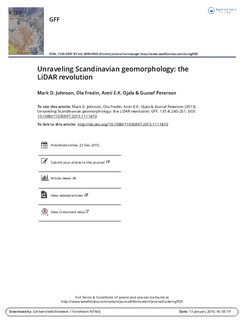| dc.description.abstract | In the observational sciences, technical advances are often followed by dramatic increases in scientific discoveries and improved theory. Leuwenhoek’s microscope and Galileo’s telescope gave us a “better look” at the microworld and the cosmos, which led to revolutions of past paradigms. In geomorphology and landscape analysis, similar advances have accompanied new maps and new mapping techniques. The first accurate globes, where the puzzle-piece fit of the southern continents was quickly noticed, were soon followed by the first mention of what would be continental drift. The first topographic maps were accompanied by similar shifts in thinking. For example, accurate topographic maps of the western US brought about the realization that even in arid regions, fluvial erosion can be the dominant landscaping force. Aerial photography provided a similar advance in observation, mapping and understanding. Satellite imagery of the Earth and other planets has dramatically revealed the geomorphic processes operating in inaccessible places, for example meteor impacts, volcanism and the importance of eolian and fluvial processes. Recent observations of Pluto and Mars attest to this fact. Satellite imagery also led to a revolution in glacial geomorphology by providing continent-wide images of features heretofore unnoticed, for example the palimpsest flow indicators of the Laurentide Ice Sheet (Boulton & Clark 1990). In the 90s, the production of digital elevation models (DEMs) and the development of geographic information system (GIS) tools allowed for new highly quantitative analysis of landscapes. The advent of LiDAR (Light Detection and Ranging) technology is poised to provide a similar rapid advance in observations and the potential for significant advances in geomorphic theory. We see that the ever increasing use of LiDAR technology is creating a similar leap forward in geomorphology, and this issue is dedicated to illustrating this fact for Scandinavia. | nb_NO |
